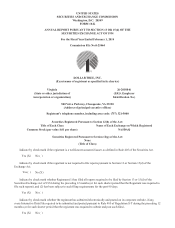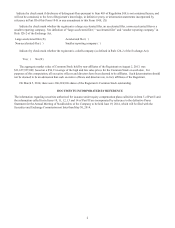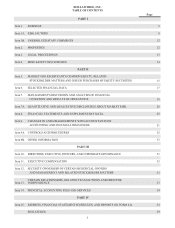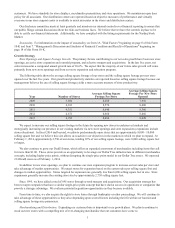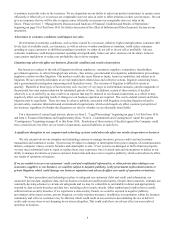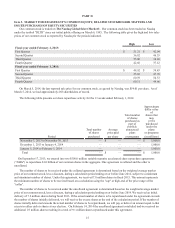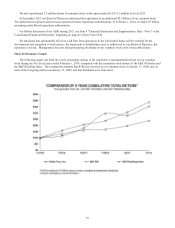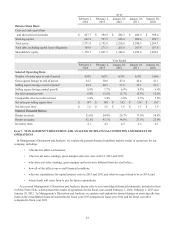Dollar Tree 2013 Annual Report Download - page 26
Download and view the complete annual report
Please find page 26 of the 2013 Dollar Tree annual report below. You can navigate through the pages in the report by either clicking on the pages listed below, or by using the keyword search tool below to find specific information within the annual report.10
Changes in federal, state or local law, or our failure to comply with such laws, could increase our expenses and expose us to
legal risks.
Our business is subject to a wide array of laws and regulations. Significant legislative changes, such as the healthcare
legislation, that impact our relationship with our workforce could increase our expenses and adversely affect our
operations. The minimum wage has increased or is scheduled to increase in multiple states and local jurisdictions and there is a
possibility that Congress will increase the federal minimum wage. Changes in other regulatory areas, such as consumer credit,
privacy and information security, product safety or environmental protection, among others, could cause our expenses to
increase. In addition, if we fail to comply with applicable laws and regulations, particularly wage and hour laws, we could be
subject to legal risk, including government enforcement action and class action civil litigation, which could adversely affect our
results of operations. Changes in tax laws, the interpretation of existing laws, or our failure to sustain our reporting positions
on examination could adversely affect our effective tax rate.
Our growth is dependent on our ability to increase sales in existing stores and to expand our square footage profitably.
Existing store sales growth is dependent on a variety of factors including merchandise selection and availability, store
operations and customer satisfaction. In addition, competition could affect our sales. Our highest sales periods are the
Christmas and Easter seasons and we generally realize a disproportionate amount of our net sales and our operating and net
income during the fourth quarter. In anticipation, we stock extra inventory and hire many temporary employees to prepare our
stores. A reduction in sales during these periods could adversely affect our operating results, particularly operating and net
income, to a greater extent than if a reduction occurred at other times of the year. Untimely merchandise delays due to
receiving or distribution problems could have a similar effect. Easter was observed on April 8, 2012, March 31, 2013, and will
be observed on April 20, 2014.
Expanding our square footage profitably depends on a number of uncertainties, including our ability to locate, lease, build
out and open or expand stores in suitable locations on a timely basis under favorable economic terms. In addition, our
expansion is dependent upon third-party developers’ abilities to acquire land, obtain financing, and secure necessary permits
and approvals. It remains difficult for third party developers to obtain financing for new projects due to the recent turmoil in
the financial markets. We also open or expand stores within our established geographic markets, where new or expanded stores
may draw sales away from our existing stores. We may not manage our expansion effectively, and our failure to achieve our
expansion plans could materially and adversely affect our business, financial condition and results of operations.
Risks associated with our domestic and foreign suppliers from whom our products are sourced could affect our financial
performance.
We are dependent on our vendors to supply merchandise in a timely and efficient manner. If a vendor fails to deliver on its
commitments due to financial or other difficulties, we could experience merchandise shortages which could lead to lost sales or
increased merchandise costs if alternative sources must be used.
Merchandise imported directly accounts for approximately 40% to 42% of our total retail value purchases. In addition, we
believe that a portion of our goods purchased from domestic vendors is imported. China is the source of a substantial majority
of our imports. Imported goods are generally less expensive than domestic goods and increase our profit margins. A disruption
in the flow of our imported merchandise or an increase in the cost of those goods may significantly decrease our profits. Risks
associated with our reliance on imported goods may include disruptions in the flow of or increases in the cost of imported
goods because of factors such as:
• raw material shortages, work stoppages, strikes and political unrest;
• economic crises and international disputes;
• changes in currency exchange rates or policies and local economic conditions, including inflation in the country of
origin; and
• failure of the United States to maintain normal trade relations with China.
We could encounter disruptions in our distribution network or additional costs in distributing merchandise.
Our success is dependent on our ability to transport merchandise to our distribution centers and then ship it to our stores in
a timely and cost-effective manner. We may not anticipate, respond to or control all of the challenges of operating our
receiving and distribution systems. Additionally, if a vendor fails to deliver on its commitments, we could experience
merchandise shortages that could lead to lost sales or increased costs. Some of the factors that could have an adverse effect on
our distribution network or costs are:
• Shipping disruption. Our oceanic shipping schedules may be disrupted or delayed from time to time.



